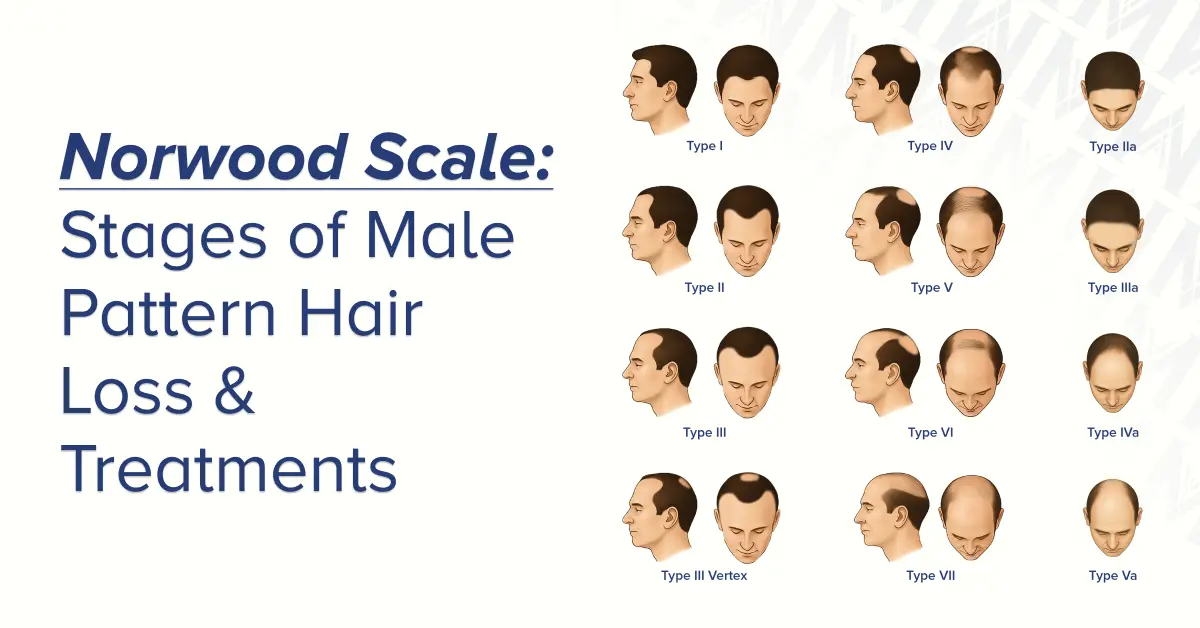The Norwood Scale is the most widely used classification system for male pattern baldness, developed by Dr. O’Tar Norwood in 1975 to categorize hair loss progression in men based on specific patterns that start at the temples and crown.
This comprehensive system serves as the global standard for hair transplant consultations, treatment planning, and medical diagnosis, helping both patients and surgeons understand the extent and pattern of androgenetic alopecia.
After studying hair loss patterns in 1,000 male subjects, Dr. Norwood created a detailed classification system that identifies 12 distinct stages across two different progression patterns, making it an essential tool for anyone considering hair restoration procedures.
The scale ranges from Stage 1 (no visible hair loss) to Stage 7 (complete baldness across the top of the scalp), with each stage providing crucial information for determining the most appropriate hair transplant approach, donor hair requirements, and realistic treatment expectations.
Key Points:
What is the Norwood Scale?
The Norwood Scale (also known as the Norwood-Hamilton or Hamilton-Norwood scale) is the most widely used classification system for male pattern baldness, developed by Dr. O’Tar Norwood in 1975. This detailed system categorizes hair loss progression in men based on specific patterns of thinning that start at the temples and crown, eventually encompassing the entire top scalp.
After studying patterned hair loss in 1,000 male subjects, Dr. Norwood created the most comprehensive classification system for androgenetic alopecia. The Norwood classification identifies two major patterns and several stages of male pattern baldness.
Norwood’s research revealed that hair loss typically begins simultaneously at the temples and crown/vertex area, progressively expanding until it affects the entire top portion of the scalp.
The Norwood classification system serves as the global standard for hair transplant consultations and planning, medical diagnosis of male pattern baldness, treatment progress tracking, research and clinical studies, and patient education.
Dr. O’Tar Norwood, a dermatologist and hair transplant surgeon, revolutionized hair loss classification by revising and improving Dr.Hamilton’s earlier system, developed in 1951. While James Hamilton created the original hair loss classification in the 1950s, Dr. Norwood’s 1975 revision became the definitive system due to its larger study population of 1,000 males, more detailed pattern recognition, better clinical applicability, and enhanced precision in stages.
How many stages are there in the Norwood Scale?
The Norwood Scale includes two different progression patterns of male pattern baldness. Across both patterns, there are 12 distinct stages in total.
- The standard pattern has 7 stages, with one additional sub-stage (Stage 3 Vertex) focused on early crown thinning
- The type “a” variant has 4 stages (2A, 3A, 4A, and 5A), where hair loss advances from the front straight back without early crown hair loss.
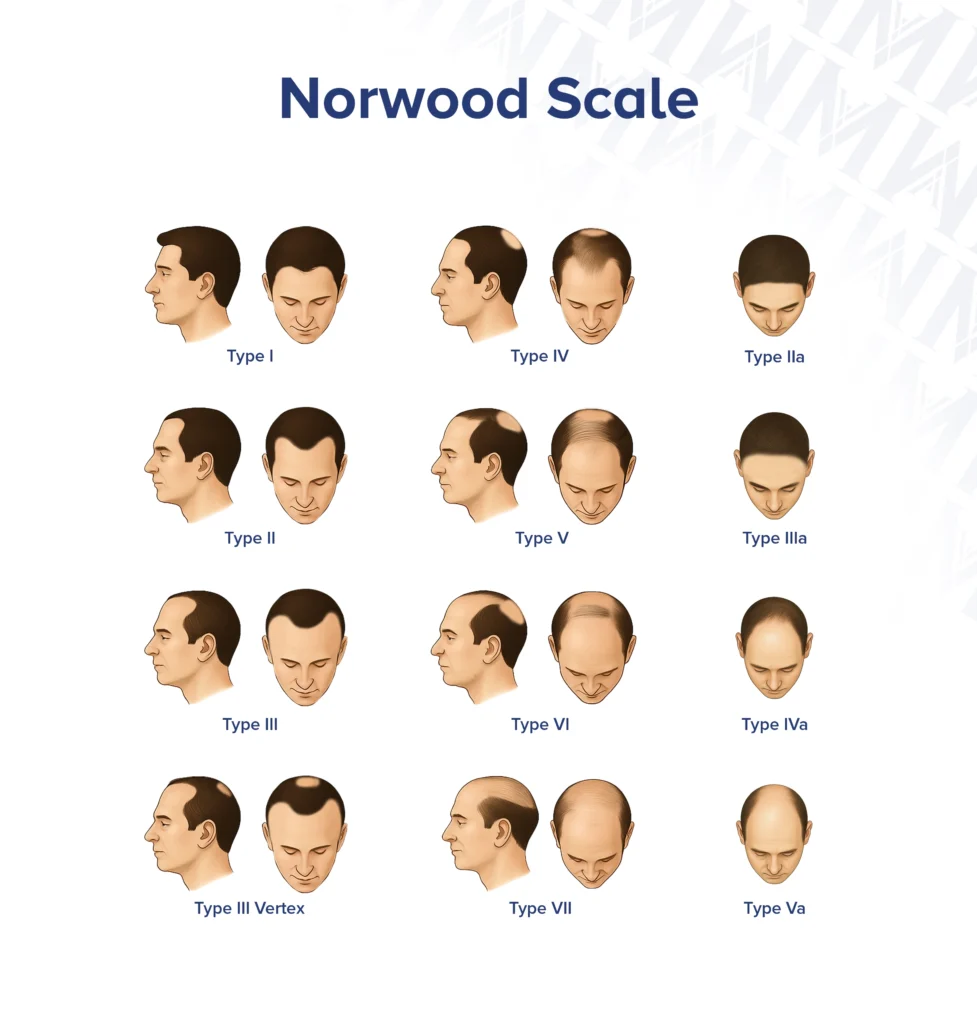
What is the “a” variant in the Norwood-Hamilton Scale?
The “a” variant is an alternative hair loss pattern described by Dr. Norwood as a frontal-dominant progression of male pattern baldness, without early crown hair loss. It is defined by two major features and two minor features.
Major features:
- The hairline recedes straight back without leaving an island of hair in the mid-frontal area.
- No bald spot forms on the crown early on. Instead, the frontal recession continues to move toward the back of the scalp.
Minor features:
- A scattering of fine, sparse hairs often remains in the bald area.
- The remaining horseshoe-shaped fringe of hair on the sides and back is usually wider and extends higher up the head than in the standard pattern.
Norwood Stage 1 Hair Loss (Norwood Type I)
Norwood Stage 1 represents no visible hair loss with a full juvenile hairline and complete hair density across the entire scalp. Norwood Stage 1 serves as the baseline reference point, showing no clinically significant hair loss in the temples or crown areas.
Hamilton originally categorized this stage as “not bald,” and it remains the ideal reference point for comparison as hair loss progresses. Most young adult males start at this stage before any onset of pattern baldness.
At this stage, there is no need for pharmaceutical or surgical intervention to treat hair loss.
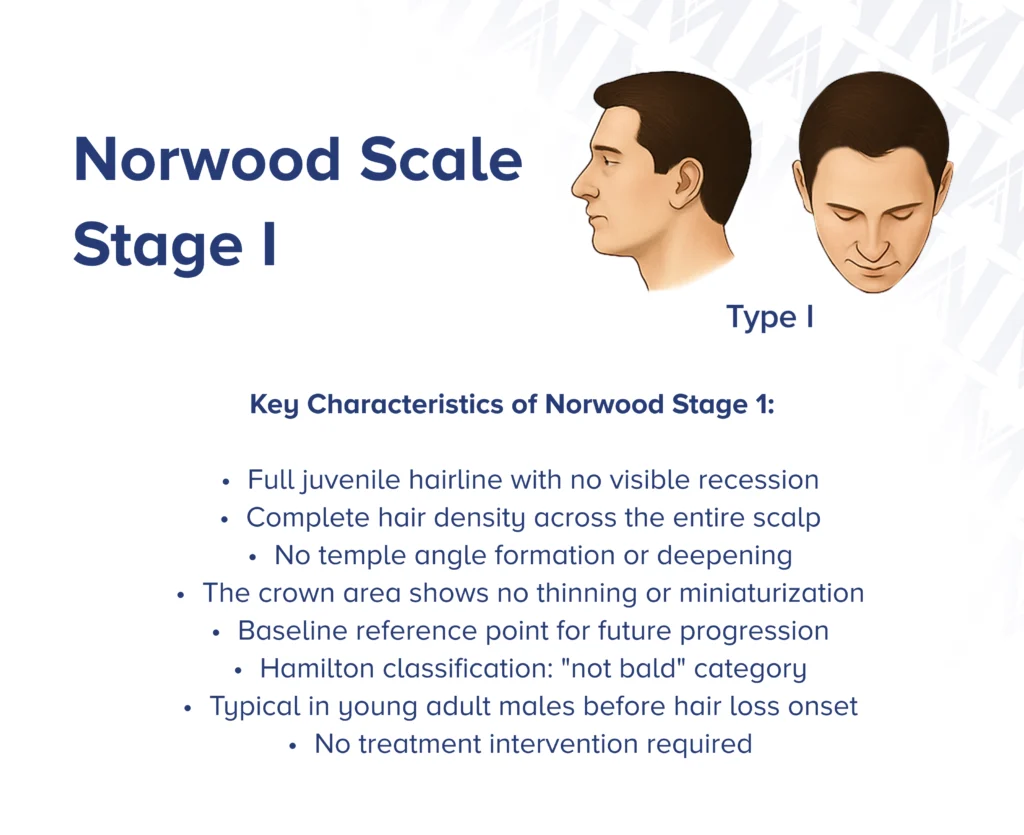
Key Characteristics of Norwood Stage 1:
- Full juvenile hairline with no visible recession
- Complete hair density across the entire scalp
- No temple angle formation or deepening
- The crown area shows no thinning or miniaturization
- Baseline reference point for future progression
- Hamilton classification: “not bald” category
- Typical in young adult males before hair loss onset
- No treatment intervention required
Norwood-Hamilton Stage 2 Hair Loss (Norwood Type II)
Norwood Stage 2 represents the earliest noticeable change from a juvenile hairline, with mild, symmetrical recession at the temples. This creates a subtle “M” or “V” shape at the front hairline but leaves the mid-frontal area intact. Hair density across the scalp remains full, and there is no visible thinning at the crown.
Hamilton originally placed this stage in the “not bald” category, as the recession is minimal and may represent the development of a mature hairline rather than true balding. However, in some men, Stage 2 can be the first step toward progressive male pattern baldness.
At this stage, most patients do not require surgical intervention. Preventive medical treatments such as minoxidil or finasteride may be considered if there is evidence of ongoing miniaturization or a strong family history of hair loss.

Key Characteristics of Norwood Stage 2:
- Mild, symmetrical recession at the temples (1–2 cm)
- Hairline maintains a defined mid-frontal point
- Subtle “M” or “V” shape to the hairline
- Full hair density in mid-scalp and crown areas
- No visible crown thinning or bald spot
- Hamilton classification: “not bald” category
- May represent a natural, mature hairline in many men
- Preventive medical therapyis optional, and surgery is rarely indicated
Norwood-Hamilton Stage 3 Hair Loss (Norwood Type III)
Norwood Stage 3 is the first stage classified as clinically significant baldness in the Norwood–Hamilton Scale. It is characterized by deep, symmetrical recession at both temples, extending well beyond the Stage 2 pattern.
These recessed areas are typically bare or only sparsely covered with fine, miniaturized hair, giving the hairline a more pronounced “M” or “U” shape when viewed from above.
The mid-frontal portion of the hairline may remain intact, but the loss at the temples is now easily visible in everyday social interactions and photographs.
Hair density across the mid-scalp and crown remains full in the standard Stage 3 pattern, though some men may show early signs of vertex thinning (classified separately as Stage 3 Vertex).
At this stage, medical treatment (such as minoxidil or finasteride) can help stabilize further loss and preserve remaining hair. Surgical intervention with a hair transplant can also be considered with long-term planning to account for further hair loss.
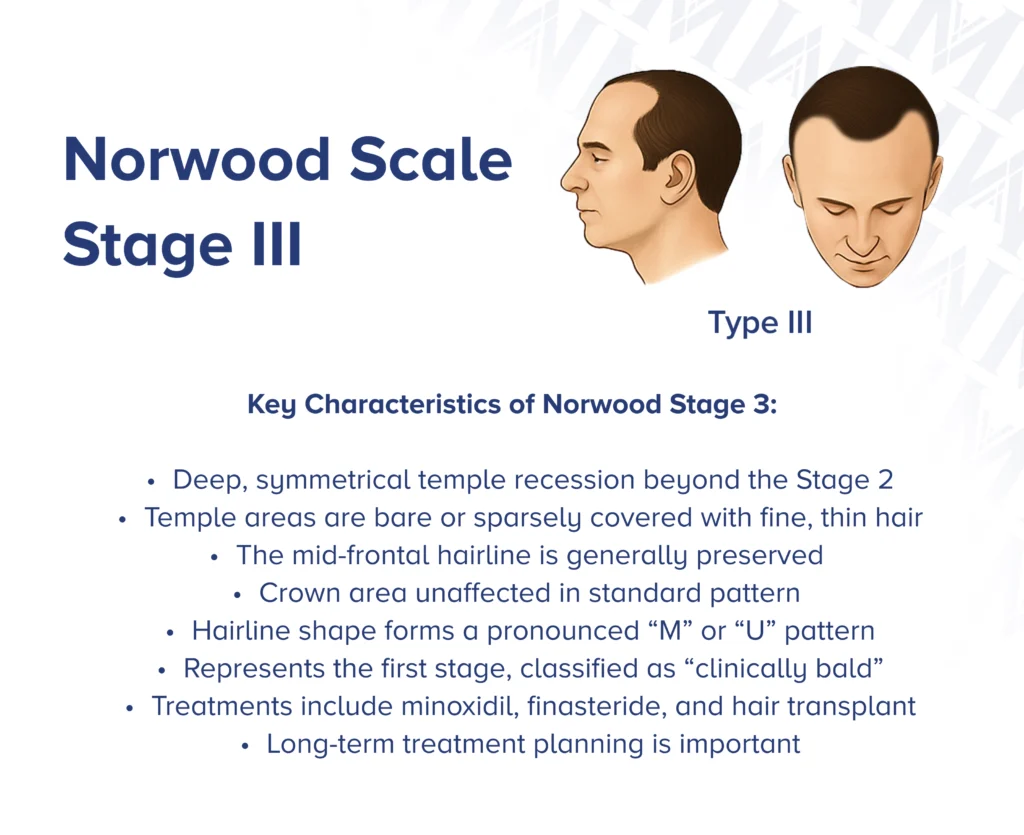
Key Characteristics of Norwood Stage 3:
- Deep, symmetrical temple recession beyond the Stage 2 pattern
- Temple areas are bare or sparsely covered with fine, thin hair
- The mid-frontal hairline is generally preserved in the standard Stage 3
- Crown area unaffected in standard pattern (crown hair loss = Stage 3 Vertex)
- Hairline shape forms a pronounced “M” or “U” pattern
- Represents the first stage, classified as “clinically bald” by Norwood
- Treatment options include minoxidil, finasteride, and hair transplant
- Long-term treatment planning is important to anticipate progression
Norwood-Hamilton Stage 3 Vertex Hair Loss (Norwood Type III Vertex)
Norwood Stage 3 Vertex is a variation of Stage 3 in which hair loss is concentrated at the crown (vertex) rather than being dominated by frontal hairline recession. In this pattern, there is a distinct bald or thinning area at the crown, while the hairline and temples show only limited recession, no greater than the degree seen in standard Stage 3. It functions as a transitional stage between stages 3 and 4.
From a top view, the bald spot at the crown is clearly visible, yet a band of normal-density hair still separates it from the frontal hairline. This pattern can be more challenging for patients to detect early, as the vertex is not easily visible without mirrors or photographs.
At this stage, medical therapy such as finasteride and minoxidil can be highly effective at slowing or reversing crown thinning. Hair transplant is considered a treatment option if the crown hair loss is stabilized.
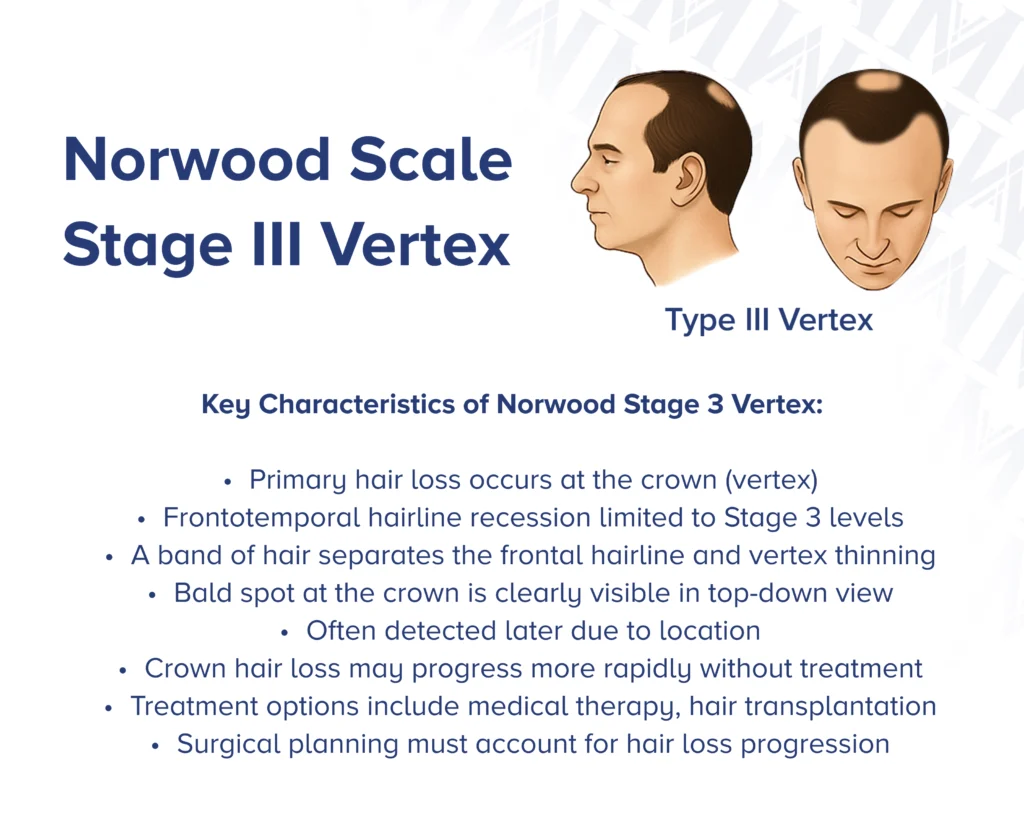
Key Characteristics of Norwood Stage 3 Vertex:
- Primary hair loss occurs at the crown (vertex)
- Frontotemporal hairline recession limited to standard Stage 3 levels
- A band of healthy hair separates the frontal hairline and vertex thinning
- A bald spot or thinning at the crown is clearly visible in a top-down view
- Often detected later due to location, requiring a mirror or photographic confirmation
- Crown hair loss may progress more rapidly without treatment
- Effective treatment options include medical therapy and, in some cases, hair transplantation
- Surgical planning must account for the possible future expansion of the bald area
Norwood-Hamilton Stage 4 Hair Loss (Norwood Type IV)
Norwood Stage 4 marks a clear progression from Stage 3, with more advanced hair loss at both the frontotemporal hairline and the crown. In this stage, the frontal hairline recession is deeper and more pronounced, while a distinct bald or thinning area has formed at the crown.
The forehead and the crown are still separated by a band of moderately dense hair across the mid-scalp. This “bridge” of hair is still fully connected to the hair on the sides of the scalp.
From a clinical perspective, Stage 4 is a transitional phase where baldness becomes highly visible in both the frontal and crown regions, but there is still enough hair between them to clearly distinguish the two zones. Patients at this stage often report difficulty styling their hair to conceal the hair loss.
At this stage, hair transplant is the main treatment option, with continued minoxidil and finasteride use after surgery to prevent further hair loss.
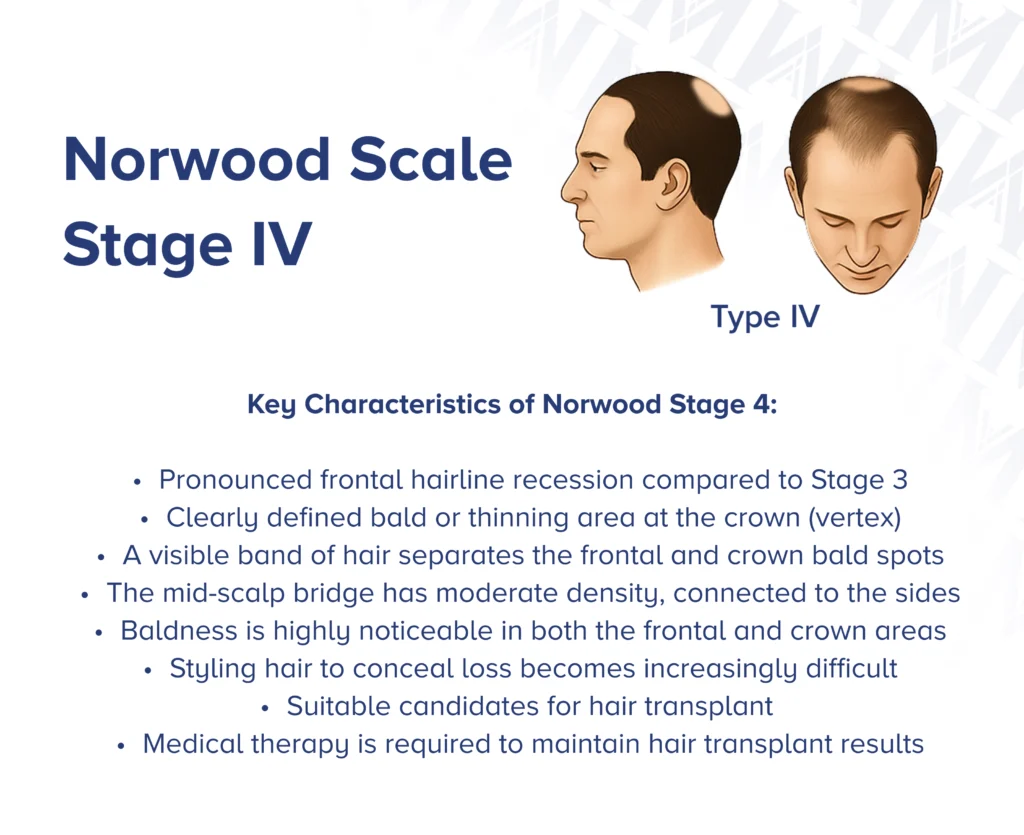
Key Characteristics of Norwood Stage 4:
- Pronounced frontal hairline recession compared to Stage 3
- Clearly defined bald or thinning area at the crown (vertex)
- A visible band of hair separates the frontal and crown bald spots
- The mid-scalp bridge has moderate density and is connected to the sides
- Baldness is highly noticeable in both the frontal and crown areas
- Styling hair to conceal loss becomes increasingly difficult
- Suitable candidates for hair transplant
- Medical therapy is required to maintain hair transplant results
Norwood-Hamilton Stage 5 Hair Loss (Norwood Type V)
Norwood Stage 5 represents a further advancement of hair loss from Stage 4, with the frontal and crown bald areas becoming larger and the mid-scalp bridge between them noticeably narrower and thinner.
At this stage, the two bald zones are separated only by a sparse band of hair. The hairline recession at the temples is deeper, and the crown bald spot has expanded significantly.
Stage 5 requires careful surgical planning for hair transplant, as covering both the frontal and crown areas with high density may not be possible in a single session. Minoxidil and finasteride are still required to maintain hair transplant results.
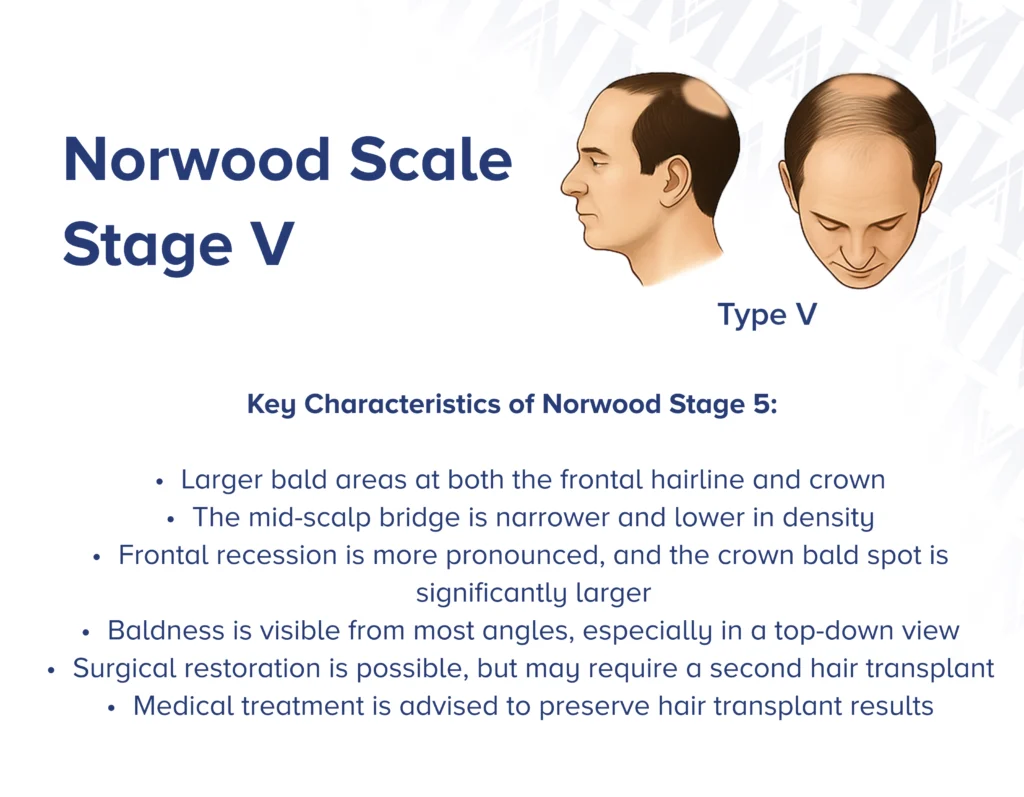
Key Characteristics of Norwood Stage 5:
- Larger bald areas at both the frontal hairline and crown compared to Stage 4
- The mid-scalp bridge is narrower and lower in density
- Frontal recession is more pronounced, and the crown bald spot is significantly larger
- Baldness is visible from most angles, especially in a top-down view
- Surgical restoration is possible, but may require a second hair transplant
- Medical treatment is advised to preserve hair transplant results
Norwood-Hamilton Stage 6 Hair Loss (Norwood Type VI)
Norwood Stage 6 marks the transition to late-stage baldness, with the mid-scalp bridge almost completely gone. Only a sparse scattering of fine hair may remain where the bridge once was, but it offers no meaningful coverage. The extent of hair loss across the top is significantly greater, making the scalp highly visible from all angles.
At this stage, complete restoration of dense hair across the entire bald area is typically not possible with surgery alone due to donor limitations. Most surgical plans focus on restoring the frontal third and mid-scalp for framing, with lower density or no surgical work at the crown.
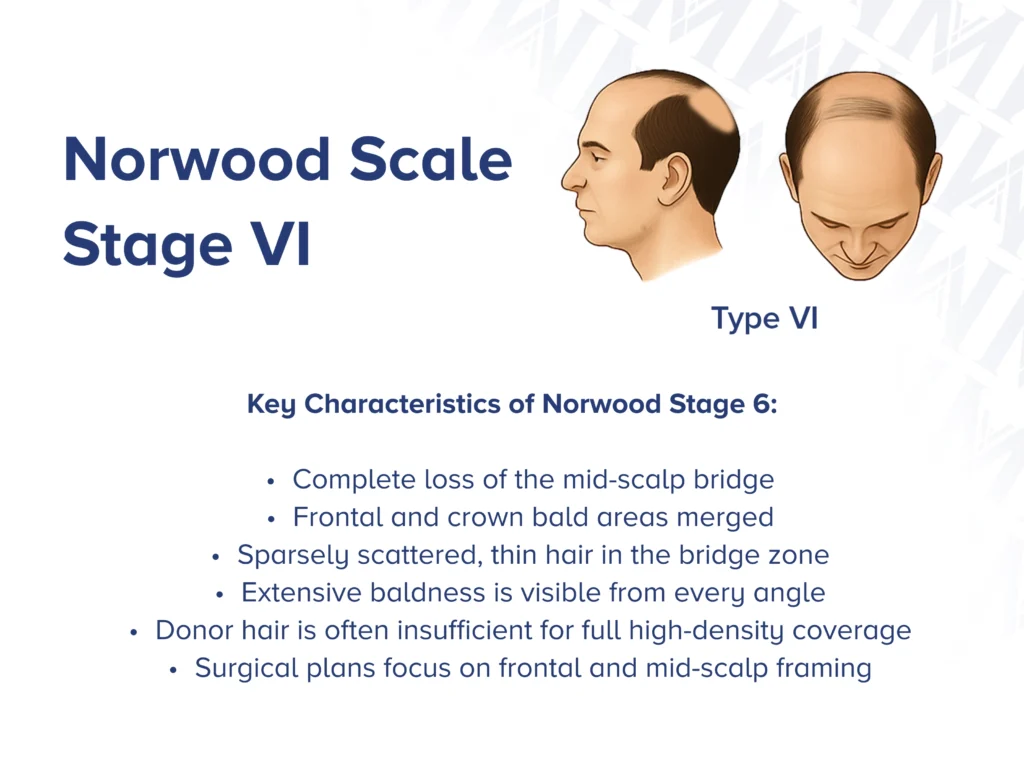
Key Characteristics of Norwood Stage 6:
- Complete loss of the mid-scalp bridge; frontal and crown bald areas merged
- Sparsely scattered, thin hair in the bridge zone
- Extensive baldness is visible from every angle
- Donor hair is often insufficient for full high-density coverage
- Surgical plans focus on frontal and mid-scalp framing
Norwood-Hamilton Stage 7 Hair Loss (Norwood Type VII)
Norwood Stage 7 is the most severe form of male pattern baldness in the Norwood–Hamilton Scale. At this stage, only a narrow horseshoe-shaped band of hair remains along the sides and back of the scalp. This remaining hair is less dense and may consist of finer, miniaturized hairs.
The bald area covers the entire top of the head, including the frontal hairline, mid-scalp, and crown, leaving the scalp fully exposed from the forehead to the occipital ridge. The transition between the bald zone and the remaining hair is smooth, with no intermediate thinning regions; only the fringe remains.
At this stage of hair loss, treatment is not possible with a hair transplant due to a limited and subpar quality donor supply. Treatment with minoxidil or finasteride is also not feasible.
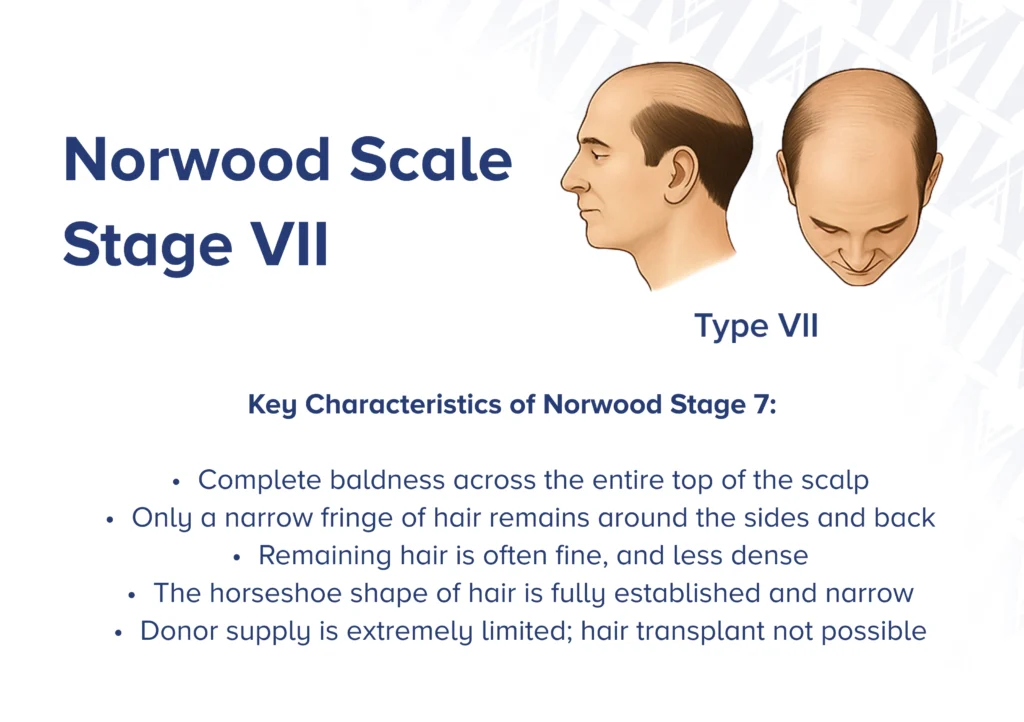
Key Characteristics of Norwood Stage 7:
- Complete baldness across the entire top of the scalp
- Only a narrow fringe of hair remains around the sides and back
- Remaining hair is often fine and less dense
- The horseshoe shape of hair is fully established and narrow
- Donor supply is extremely limited; hair transplant not possible
Norwood-Hamilton Stage 2a Hair Loss (Norwood Type IIa)
Norwood Stage 2a is the earliest stage of the Type a variant. In this pattern, the hairline moves straight back across the forehead without creating an “M” shape, and there is no bald spot forming on the crown yet.
At this stage, the hairline sits slightly further back than normal, about 2 cm in front of an imaginary line running over the top of the head between the ears (above where the ear canal opening is).
The recession is even across the front instead of being deeper in the temples like in the standard Stage 2 pattern. You may also notice a few thin, fine hairs scattered in the receded area.
At this stage, treatment with minoxidil and finasteride can start, but a hair transplant is usually not needed.
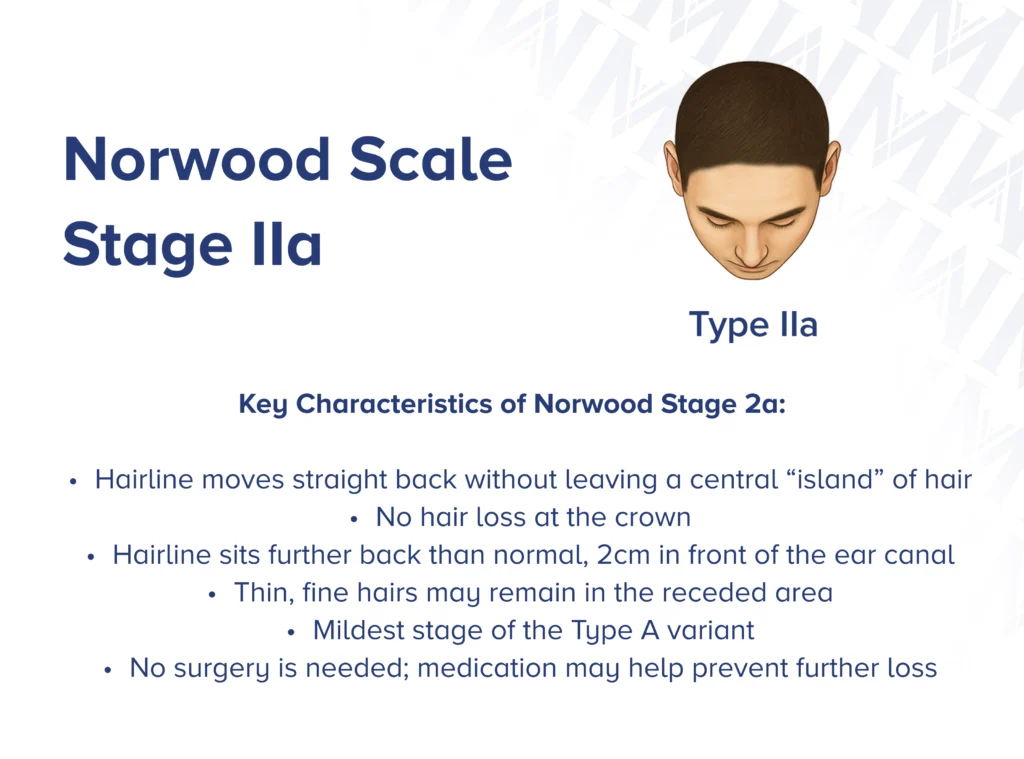
Key Characteristics of Norwood Stage 2A:
- Hairline moves straight back without leaving a central “island” of hair
- No hair loss at the crown
- Hairline sits slightly further back than normal, but 2cm in front of the ear canal opening
- Thin, fine hairs may remain in the receded area
- Mildest stage of the Type A variant
- Usually, no surgery is needed; medication may help prevent further loss
Norwood-Hamilton Stage 3a Hair Loss (Norwood Type IIIa)
Norwood Stage 3A is the second stage of the Type A variant. In this pattern, the hairline has moved straight back further than in Stage 2A, and has reached the line of the ear canal opening. There is no bald spot on the crown at this stage; the hair loss is entirely at the front.
The recession is even across the hairline, without the deep temple angles seen in the standard Stage 3. A few thin or fine hairs may still be scattered in the receded area.
At this stage, most patients still have a strong donor supply, and complete restoration of the frontal area is possible with a hair transplant. Minoxidil and finasteride use is encouraged to maintain hair transplant results.
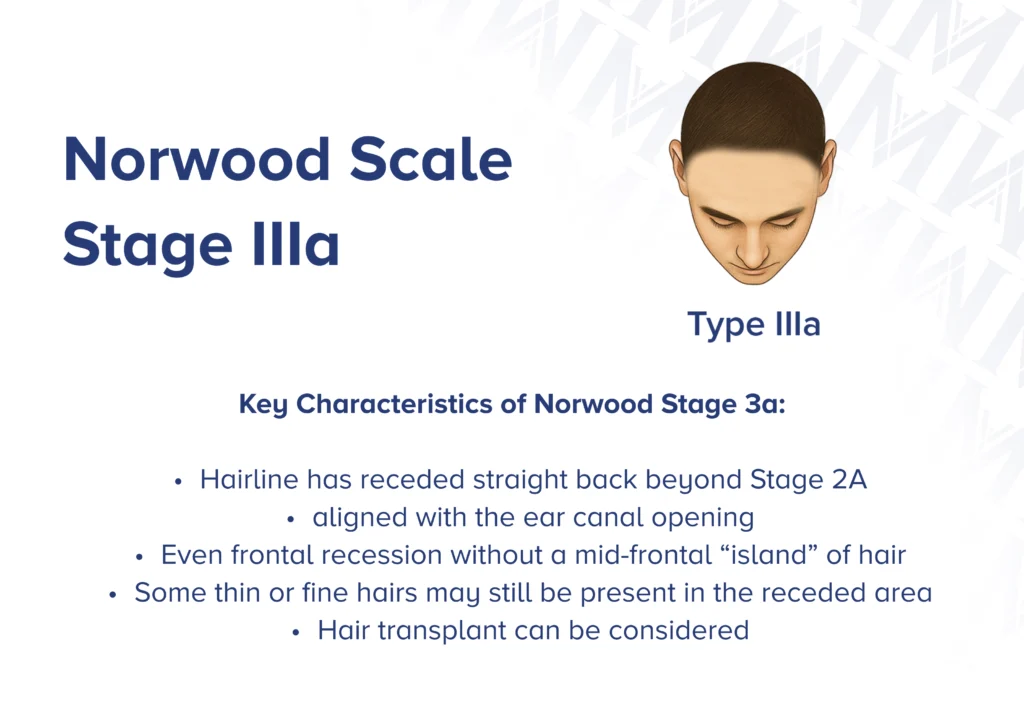
Key Characteristics of Norwood Stage 3A:
- Hairline has receded straight back beyond Stage 2A, aligned with the ear canal opening
- Even frontal recession without a mid-frontal “island” of hair
- Some thin or fine hairs may still be present in the receded area
- Hair transplant can be considered
Norwood-Hamilton Stage 4a Hair Loss (Norwood Type IVa)
Norwood Stage 4A is an advanced stage of the Type A variant in the Norwood–Hamilton Scale. In this pattern, the hairline has receded straight back beyond the level of the external auditory meatus (the top of the ear canal) but still has not reached the crown area. The hair loss remains confined to the frontal and mid-scalp areas, with no bald spot or thinning at the vertex.
The recession is even across the entire front of the scalp, producing a broad, open forehead and moving the hairline significantly toward the back of the head. Thin, fine hairs may still be visible in the receded zone, but they provide no coverage.
At this stage, a hair transplant is possible but requires a good amount of donor hair with sufficient quality. If the donor area is not sufficient, hairs need to be placed strategically, and a second hair transplant might be needed.

Key Characteristics of Norwood Stage 4A:
- Hairline has receded straight back beyond the level of the ears
- No bald spot or thinning at the crown
- Recession is uniform, without a mid-frontal “island” of hair
- Thin or fine hairs may be scattered in the bald area
- A larger frontal bald area may require more grafts if surgery is chosen
- Medical therapy is recommended to preserve the remaining hair and transplant results
Norwood-Hamilton Stage 5a Hair Loss (Norwood Type Va)
Norwood Stage 5A is the most advanced stage of the Type A variant in the Norwood–Hamilton Scale. At this point, the frontal hairline has receded so far back that the bald area now includes the vertex (crown). The hair loss pattern is continuous from the front hairline to the crown, with no remaining band of hair separating the two regions.
The remaining hair is confined to the sides and back of the scalp, forming a wide horseshoe-shaped fringe that sits slightly higher than in the standard Norwood pattern 7.
Hair loss more severe than Stage 5A is no longer distinguishable from standard Norwood Stages 6 or 7, as the patterns converge into the most advanced forms of baldness.
At this point, hair transplant is an option that is limited by donor supply and quality, and treatment often focuses on strategic coverage.
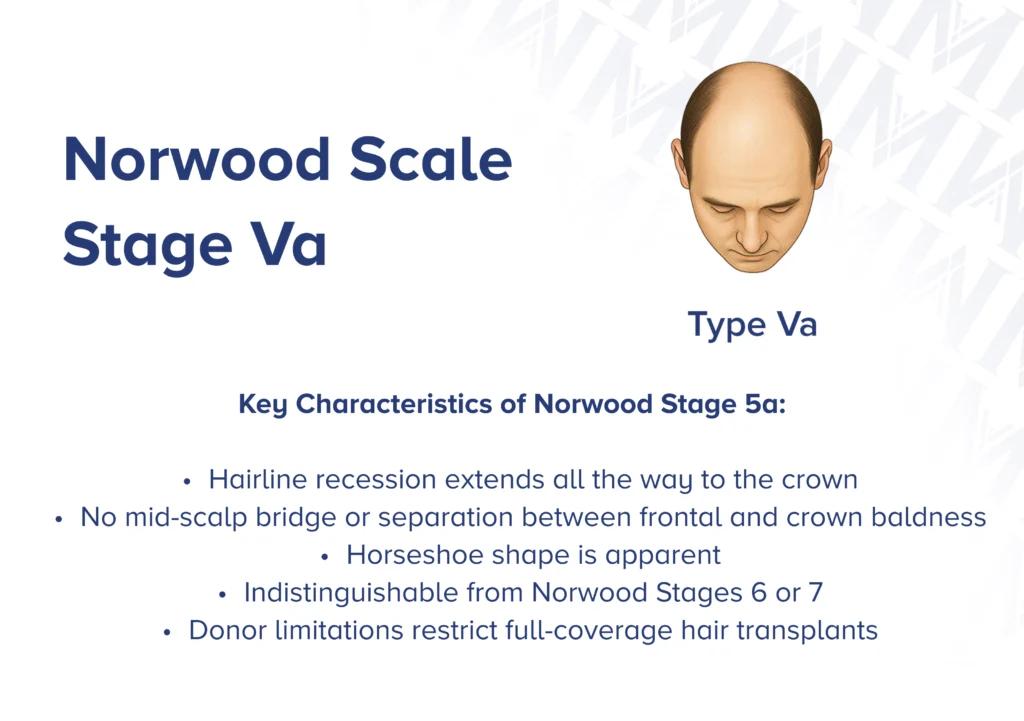
Key Characteristics of Norwood Stage 5A:
- Hairline recession extends all the way to the crown
- No mid-scalp bridge or separation between frontal and crown baldness
- Horseshoe shape is apparent
- Indistinguishable from Norwood Stages 6 or 7
- Donor limitations restrict full-coverage hair transplants
How to find your Norwood-Hamilton stage?
To find your Norwood hair loss stage, examine your hairline in good lighting using a mirror from front, top, and side angles. Take photos to compare with Norwood scale reference images, looking for temple recession depth, crown thinning, and whether any hair bridge connects the frontal and vertex areas.
Step-by-Step Self-Assessment Process:
- Prepare Your Assessment Area: Find a well-lit mirror, preferably with natural lighting, and gather reference images of the Norwood scale stages for comparison.
- Clean and Style Hair Normally: Wash and style your hair as you usually would to get an accurate representation of your current hairline.
- Examine Front Hairline: Look directly at your hairline from the front, noting any temple recession, M-shape formation, or overall hairline position.
- Check Temple Angles: Observe the depth and symmetry of temple recession, measuring approximately how far back from your juvenile hairline.
- Assess Crown Area: Use a handheld mirror or phone camera to examine the crown/vertex area for thinning or bald spots.
- Document With Photos: Take clear photos from front, top, and both side angles using consistent lighting and camera distance.
- Compare to Reference Images: Match your observed patterns with official Norwood scale stage descriptions and visual references.
- Look for Bridge Hair: If you have both frontal and crown loss, assess whether connecting hair remains between these areas.
- Consider Progression Rate: Note how quickly changes have occurred and whether loss appears active or stable.
- Record Your Assessment: Document your findings with date and photos for future comparison and to provide during professional consultation.
A professional hair loss assessment provides significantly more accuracy than self-evaluation alone. Dermatologists and hair restoration specialists use advanced diagnostic tools, including trichoscopy for microscopic follicle examination, hair density measurements, and standardized photography techniques.
These professional evaluations assess not only visible patterns but also follicle health, hair shaft characteristics, and progression risk factors that influence treatment planning decisions that are not part of hair loss classification systems.
Does a higher Norwood-Hamilton stage equal bad hair transplant results?
Not necessarily. A higher Norwood–Hamilton stage simply means more advanced hair loss; it doesn’t automatically mean you’ll get bad results. However, it does affect what’s possible with a transplant:
- Donor hair limits: At higher stages (like VI or VII), there’s less hair available to move, so it may not be possible to fully restore dense coverage across the entire bald area.
- Coverage strategy: Surgeons usually focus on restoring the frontal hairline and mid-scalp for framing, rather than trying to fill the whole top to high density.
- Expectations: Results can still look excellent if goals are realistic and the design suits your head shape, donor supply, and styling preferences.
Can you get a hair transplant at Norwood-Hamilton stage 7?
At Norwood–Hamilton Stage 7, the entire top of the scalp is bald, and only a narrow horseshoe-shaped fringe of hair remains on the sides and back. This means:
- Donor hair is very limited, often not enough to cover the whole top at high density.
- Full restoration isn’t possible; surgeons typically focus on creating a small frontal hairline or forelock for framing rather than full coverage.
- Density will be lower; results rely on careful placement and design to create the appearance of fullness.
- Other options may be combined, such as scalp micropigmentation (SMP) or a hair system, to blend the transplant with the bald areas.
- Not everyone is a candidate; the strength, density, and stability of the remaining donor hair must be assessed before surgery.
Why do we classify hair loss into stages?
We classify hair loss into stages to make it easier to diagnose, communicate, and plan treatment. A staging system, like the Norwood–Hamilton Scale, gives both doctors and patients a clear, shared language to describe how far hair loss has progressed.
Key reasons include:
- Accurate diagnosis: Staging helps identify the pattern and severity of hair loss quickly.
- Tracking changes over time: By comparing stages at different points, doctors can measure how fast hair loss is progressing.
- Treatment planning: Certain treatments work better at earlier stages, while advanced stages may need different strategies or a combination of approaches.
- Realistic expectations: Staging shows what is and isn’t possible with medical or surgical treatments at a given point.
- Research and record-keeping: Standardized stages make it easier to document cases and compare results between clinics or studies.
In short, staging turns a subjective problem into an objective framework, helping both patient and doctor make the best decisions for long-term hair preservation and restoration.
How do hair transplant surgeons use the Norwood-Hamilton Scale?
Hair transplant surgeons use the Norwood–Hamilton Scale as a planning tool and communication aid, helping surgeons deliver natural, long-lasting results while keeping patients informed and confident about their treatment plan.
Here’s how it’s applied in practice:
- Assessing the pattern and severity: The scale shows whether a patient’s loss is early, moderate, or advanced, and which areas are affected (frontal hairline, temples, crown, or both).
- Estimating future progression: Knowing the stage helps the surgeon predict how hair loss may advance, which is critical for designing a transplant that will still look natural years later.
- Designing the hairline: The stage influences how high or low the new hairline should be placed to match the patient’s age, donor supply, and potential future loss.
- Planning graft distribution: Advanced stages require careful allocation of donor hair, often prioritizing the frontal hairline and mid-scalp over the crown.
- Explaining treatment options: Surgeons use the scale to explain which results are realistic at the patient’s stage and why certain approaches (like combining surgery with medication or SMP) might be recommended.
What are the limitations of the Norwood-Hamilton Scale?
The Norwood–Hamilton Scale is useful but has several limitations:
- Only used for male pattern baldness
- Different observers may assign different stages to the same patient
- Doesn’t measure hair density or miniaturization
- Not all men follow the standard progression; some have isolated crown loss, asymmetrical thinning, or other unusual patterns
- Can be too detailed for treatment planning
Modern systems address these issues. The BASP system (Lee, 2007) works for both men and women, combining hairline shape with density grading at the front and crown, and has shown better consistency between observers.
Does the Norwood-Hamilton Scale account for hair density?
No, the Norwood–Hamilton Scale does not account for hair density.
It is designed to classify the pattern and extent of hair loss, such as where recession or thinning is occurring (frontal hairline, temples, crown) and how far it has progressed. It does not measure:
- How thick or thin the remaining hair is
- The number of hairs or follicular units per square centimeter
- The degree of miniaturization within existing hair
This means two people at the same Norwood stage can look quite different — one might have thick, coarse remaining hair, while another has finer, less dense hair.
For a complete assessment, surgeons combine the Norwood–Hamilton stage with hair density measurements, shaft caliber analysis, and donor area evaluation before planning treatment.
Does the Norwood-Hamilton Scale account for donor quality?
The scale only describes the pattern and extent of hair loss on the scalp. It does not measure:
- The thickness or caliber of donor hair shafts
- The health or stability of the follicles in the donor area
- How well the donor hair matches the patient’s native hair in texture or curl
Are there other hair loss classification scales?
Yes, there are other hair loss classification scales:
- Beek Scale: Developed in 1950, Dr. Beek evaluated 1000 caucasian males to describe 2 types of hair loss; frontal baldness and frontovertical baldness.
- Hamilton Scale: Developed in 1951, the Hamilton scale classified hair loss into 10 types.
- Ogata Scale: Developed in 1953, the Ogata scale classified hair loss into 15 types in Japanese men.
- Setty Scale: Developed in 1970, the Setty Scale studied hair loss in 300 white and 300 black men, and classified hair loss into 3 general types.
- Bouhanna Scale: Developed in 1976 based on hair loss patterns in European males, this scale has 6 types of hair loss.
- Koo Scale: Developed in 200 with studies on 1700 Korean males, the Koo scale classifies hair loss into lettered stages, which resemble the shape of the hair loss pattern.
- Ebling and Rook Scale: Developed in 1975, the scale classifies female hair loss into 5 stages.
- Ludwig Scale: Developed in 1977, the Ludwig scale classified 3 stages of hair loss in females.
- Savin Scale: Developed in 1997, this scale broadens the classification of hair loss in females with 9 stages.
- Basic and Specific Classification: Developed in 2007, this scale is the most detailed scale that can be applied to both males and females. Hair loss is classified with the combination of a “basic” type and a “specific” type.
Norwood Scale vs Hamilton Scale
Dr. Norwood built his classification on the work of Hamilton. Originally, in the Hamilton Scale, type 3 did not correspond to a 3rd stage of progressive hair loss, but indicated atypical hair loss not related to pattern baldness. Dr. Norwood’s system also has a more detailed classification of crown (vertex) hair loss.
Norwood-Hamilton Scale vs Ludwig Scale
The Norwood-Hamilton scale is the most commonly used hair loss classification system for male pattern baldness, while the Ludwig scale is the most commonly used classification system for female pattern baldness.
In males, hair loss typically begins with thinning at the temples, leading to a receding hairline. Over time, this can progress to crown hair loss, eventually merging into a “horseshoe” shape. In females, pattern hair loss usually starts at the middle part of the hair, accompanied by diffuse thinning. This process requires a completely different classification system.
Norwood-Hamilton Scale vs BASP Scale
The Norwood-Hamilton scale is the most widely utilized system for classifying hair loss in male pattern baldness, while the BASP Scale is a gender-neutral classification system. While the Norwood-Hamilton Scale does not account for hair loss density, the BASP system does, and allows for detailed and gender neutral classification of hair loss.

